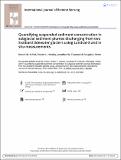Quantifying suspended sediment concentration in subglacial sediment plumes discharging from two Svalbard tidewater glaciers using Landsat-8 and in situ measurements
Date
02/12/2017Metadata
Show full item recordAbstract
Marine-terminating outlet glaciers discharge mass through iceberg calving, submarine melting, and meltwater run-off. While calving can be quantified by in situ and remote-sensing observations, meltwater run-off, the subglacial transport of meltwater, and submarine melting are not well constrained due to inherent difficulties observing the subglacial and proglacial environments at tidewater glaciers. Remote-sensing and in situ measurements of surface sediment plumes, and their suspended sediment concentration (SSC), have been used as a proxy for glacier meltwater run-off. However, this relationship between satellite reflectance and SSC has predominantly been established using land-terminating glaciers. Here, we use two Svalbard tidewater glaciers to establish a well-constrained relationship between Landsat-8 surface reflecance and SSC and argue that it can be used to measure relative meltwater run-off at tidewater glaciers throughout a summer melt season. We find the highest correlation between SSCs and Landsat-8 surface reflectance by using the red + NIR band combination (r2 = 0.76). The highest correlation between SSCs and in situ field spectrometer measurements is in the 740-800 nm wavelength range (r2 = 0.85), a spectral range not currently measured by Landsat. Additionally, we find that in situ and Landsat-8 measurements for surface reflectance of SSCs are not interchangeable and therefore establish a relationship for each detection method. We then use the Landsat-8 relationship to calculate total surface sediment load, finding a strong correlation between total surface sediment load and a proxy for meltwater run-off (r2 ≥ 0.89). Our results establish a new metric to calculate SSCs from Landsat-8 surface reflectance and demonstrate how the SSC of subglacial sediment plumes can be used to monitor relative seasonal meltwater discharge at tidewater glaciers.
Citation
Schild , K M , Hawley , R L , Chipman , J W & Benn , D I 2017 , ' Quantifying suspended sediment concentration in subglacial sediment plumes discharging from two Svalbard tidewater glaciers using Landsat-8 and in situ measurements ' , International Journal of Remote Sensing , vol. 38 , no. 23 , pp. 6865-6881 . https://doi.org/10.1080/01431161.2017.1365388
Publication
International Journal of Remote Sensing
Status
Peer reviewed
ISSN
0143-1161Type
Journal article
Description
This work was supported by National Science Foundation IGERT award: [Grant Number DGE-0801490]; National Science Foundation GK-12 award: [Grant Number DGE-0947790]; NASA supplement award: [Grant Number NNX10AG22G]; American Alpine Club under their Research Grant; Geological Society of America under their Research Grant; the ConocoPhillips-Ludin Northern Area Program under the CRIOS project (Calving Rates and Impact on Sea Level); and Dartmouth Earth Sciences Department.Collections
Items in the St Andrews Research Repository are protected by copyright, with all rights reserved, unless otherwise indicated.

